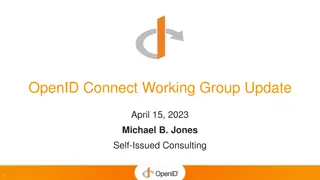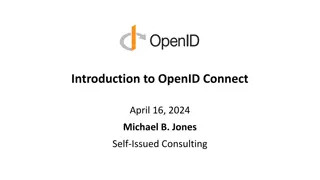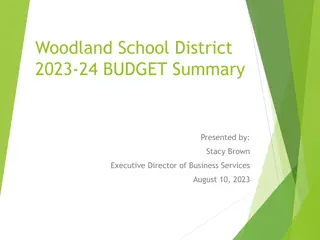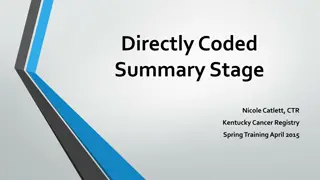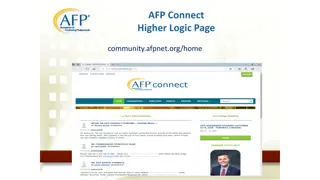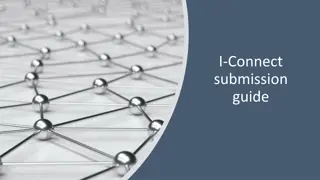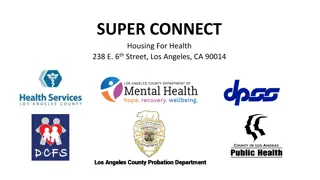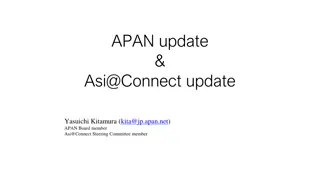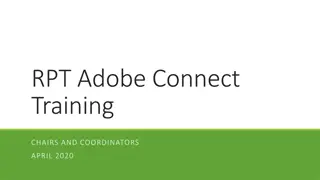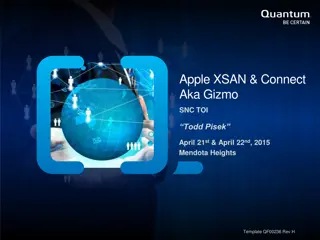Future Connect 2023 Summary Document Overview
Future Connect 2023 is a core guidance resource for Auckland's strategic network, providing a whole-system view of the networks across different modes of transport. It outlines key challenges, informs investment planning decisions, and has been updated in preparation for the 2024-2034 Regional Land Transport Plan. The document includes an overview, changes, improvements, and key findings of Future Connect. It serves as a vital planning tool and evidence base for the development of the RLTP and subsequent transportation projects. Future Connect maps strategic networks, analyzes them, identifies key challenges, and highlights focus areas for investment to address regional challenges effectively. The update of Future Connect aims to keep the information current and relevant for future planning initiatives.
Download Presentation

Please find below an Image/Link to download the presentation.
The content on the website is provided AS IS for your information and personal use only. It may not be sold, licensed, or shared on other websites without obtaining consent from the author.If you encounter any issues during the download, it is possible that the publisher has removed the file from their server.
You are allowed to download the files provided on this website for personal or commercial use, subject to the condition that they are used lawfully. All files are the property of their respective owners.
The content on the website is provided AS IS for your information and personal use only. It may not be sold, licensed, or shared on other websites without obtaining consent from the author.
E N D
Presentation Transcript
Attachment 1 Revised version of Auckland s Strategic Network Guidance Future Connect 2023: Summary Document September 2023
What this is Future Connect is a core guidance resource which represents the whole-of-system view of the network. It maps the most important links for all modes, analyses these networks to map key challenges, and inform investment planning decision-making. Future Connect was developed in 2020 and first published in 2021. Why are we talking about it: Future Connect has been updated in preparation of work commencing on the 2024- 2034 Regional Land Transport Plan. Outline of this pack 1. Overview of Future Connect 2. Changes and improvements 3. Summary of key findings
Future Connect 2023 1. Overview of Future Connect
What is Future Connect? AT s whole-of-network view GPS - Government Policy Statement on Land Transport Auckland Plan 2050 A key planning tool and evidence base that builds on and synthesises higher-order plans like the Auckland Plan and guides the development of the RLTP and subsequent project planning, design, delivery and operations. ATAP Auckland Transport Alignment Project An online mapping portal highlighting three key outputs: Strategic Networks for all modes of transport Transport System Analysis, highlighting issues and opportunities Focus Areas for investment, our key challenges to overcome RLTP Regional Land Transport Plan Future Connect currently has a ten-year horizon and displays both the current and future state of the networks. Other AT plans (RPTP Room to Move etc) Future Connect A summary of Future Connect and its part in the system planning process for transport in Auckland is shown to the side. NOP the Network Operating Plan Asset Mgmt Plan RASF Roads and Streets Framework
How Future Connect works We map our strategic networks, analyse them, and distill our key challenges Strategic Networks Current First Decade The most important links for the movement of goods and people across the region, now and considering future growth and plans System Analysis Issues Opportunities Using current and forecast data to map issues and opportunities for all modes and the three intermodal problems: safety, environment and equity Focus Areas Bringing all the data together into a map of key regional challenges
Why did we update Future Connect We need to update Future Connect in preparation for the next Regional Land Transport Plan, and to ensure it stays up to date. In August 2022, we informed the ELT and the AT Board that work had started on updating Future Connect for the following reasons: A new version of Future Connect is needed to support the development of the 2024-2034 RLTP. Networks needed to be updated in response to latest plans, projects and strategies. We had identified improvement opportunities after using the tool for some time.
Future Connect 2023 2. Changes and improvements
What changes and improvements did we make? Mapping Portal Updates Updated all three key outputs: StrategicNetworks, shifting from 2021-2031 to 2024-2034 Improved systemanalysis with new data and indicators, as well as greater distinction between deficiencies and opportunities Focus Areas now tell a more compelling story about Auckland s key challenges We ve moved beyond corridor analysis and consider community needs, in the form of a Transport Equity Analysis. Fully incorporated the walking network, which was separate in the 2020 version and did not have a full deficiency analysis done. Incorporated outputs of the RTN Station Access Study Added contextual data to mapping portal, allowing for the easy creation of maps Report Updates Refresh of Summary Report Refresh of Technical Report
Future Connect 2023 3. Key findings and outputs
Strategic Networks System Analysis Focus Areas In Future Connect 2021, networks were based on Existing plans, such as the Auckland Plan, 2018 RPTP, 2018-2028 RLTP, The Freight Plan, and the Cycle and Micromobility Network The first-decade networks were informed by expected RLTP projects and greenfield/brownfield growth. In Future Connect 2023 we ve updated these networks to Show how the network changes from 2024 to 2034, instead of 2021- 2031, the period covered by the original version of Future Connect Reflect newly delivered projects (Puhoi to Warkworth, Eastern Busway Stage 1, etc) Incorporate new thinking coming out of business cases (Cycling SSBCs, Supporting Growth Alliance, etc) Reflect new plans and strategies (2021-2031 RLTP, Draft RPTP) Our strategic networks are expected to grow by 8%, or 260 km, over the next ten years.
Strategic Networks System Analysis Focus Areas This and the following slide provide an overview of the full updated 2034 Strategic Network for each mode covered by Future Connect. Supporting Networks (lower order links) for each network are not pictured, but are included in the GIS portal.
Strategic Networks System Analysis Focus Areas
Strategic Networks System Analysis Focus Areas 2034 Multimodal Deficiencies Mapping existing deficiencies, and what gets worse in 2034 Using 20 Indicators, several for each mode, and two intermodal problems (safety & environment) Current and forecast data, to identify where things are bad, and where they get worse In Future Connect 2023, we ve updated our indicators to use newer and better data. Deficiencies are only mapped on Strategic Network Links. For each mode, the severity of the deficiency is ranked using the strategic network hierarchy. Future Connect also maps opportunities for each mode, to highlight where proactive investment can be most beneficial. Multimodal Deficiency Map Ranked deficiency scores for each mode and problem are added together into a Multimodal Deficiency Score (shown to the right) that indicates corridors with multiple significant deficiencies. These corridors have a few high-ranking issues, or many smaller ones. The Future Connect Mapping Portal allows users to easily switch between this deficiency map and individual maps for each mode/problem, to see why corridors are coming up as deficient. The deficiency analysis provides a useful evidence base for those working on Auckland s future transport network.
Strategic Networks System Analysis Focus Areas High level summary of data considered for each mode and problem Public Transport Walking Cycling Deficiencies AM and PM Speed Level of Service AM and PM Reliability Level of Service Patronage/Capacity Ratio changes (forecast) Deficiencies Footpath width compared to TDM Standard Distance between priority crossings on busy roads Deficiencies Unsafe or no facilities Opportunity Routes without facilities in the catchment of centres, schools, RTN Stations Routes without facilities connecting to built/committed facilities Opportunity Footpaths inside intervention areas identified in the Walking Programme Business Case Opportunity Routes identified for service improvements in the RPTP Public Transport Freight Environment Deficiencies AM and PM Speed and Productivity Level of Service AM and PM Reliability Level of Service AM and PM volume/Capacity Ratio changes (forecast) Deficiencies AM and Interpeak Speed Level of Service AM Volume/Capacity Ratio Changes (forecast) Deficiencies Untreated Stormwater Runoff Coastal Erosion and flooding risk Opportunity Routes with significant forecast freight volumes Opportunity High place value areas with high heat vulnerability and few street trees. Safety Deficiencies: where our customers or the environment experience outcomes that fall short of AT s strategic objectives, either now or in the future. Deficiencies Urban KiwiRAP Collective Risk Urban KiwiRAP Active Road User Risk Opportunities: where proactive improvement initiatives would likely achieve the highest impacts on customer experience, environment, or other strategic outcomes.
Strategic Networks System Analysis Focus Areas Transport Equity A new intermodal problem, based on the draft Auckland Transport Equity Framework, investigating how transport outcomes are distributed across the region Follows a high-resolution GIS analysis that measures regional transport outcomes for across three domains: Local Access (key destinations in community), Regional Access (jobs and people using various modes), and Transport System Disbenefits (negative impacts such as safety risk) Multiple measures, surfaced through research conducted within the Auckland Transport Equity Framework, were considered for each domain. Measures include distance to nearest PT stop, access to population via PT, or percentage of roads with high safety risk in local area. Different measures for Rural and Urban areas, as travel behaviors differ. Urban measures have a stronger focus on walking, cycling and PT. We want to know where vulnerable people experience poor outcomes across one or more of these domains.
Strategic Networks System Analysis Focus Areas Key findings Not all High Deprivation Areas have transport problems, and not all transport problems affect people in high deprivation areas However, people in high deprivation areas may lack the means to overcome barriers put up by the transport system; especially when poor outcomes across multiple domains are experienced. The map to the right highlights high deprivation areas that experience poor outcomes across one or multiple domains of transport equity. Priority Areas across the region West and South - It s difficult to walk and cycle to local destinations, and people can t access jobs and population. People also experience noise, safety and severance issues. Closer to the city Although Regional Access is better, poor local access and transport system disbenefits are found in many high deprivation areas. Certain rural areas are impacted too, although the share of the population living in these areas is small. The equity analysis will help us prioritise investment in communities that are most at need
Strategic Networks System Analysis Focus Areas Bringing together all the data into a map of key regional challenges Four key themes stood out Deficient Movement Patterns Key regional commuting flows Often reliant on congested and worsening general traffic networks with high safety/environmental risks and limited competitive alternatives Likely to require significant central government investment Multimodal Streets with Space and Safety Constraints Local Roads that are relied upon for several modes, with high deficiencies for many. Often historical corridors with land use interactions further impacting movement function. Major Destinations with complex transport interconnections Key hubs around the city where people work and study Regional and local transport networks interchange Land use interactions further complicating movement function Transport Deprivation Priority Areas Areas experiencing poor outcomes across two or three equity domains






